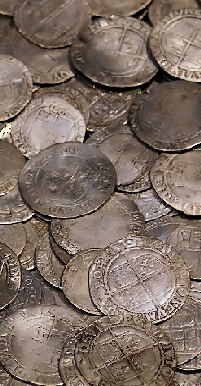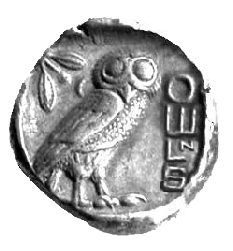
● Next Meeting Status:
Cancelled



● Host Society for the
BANS 2011 Congress
held in Southport


Public House Tokens
Public House Tokens From The Mid-
Bob Lyall
One of the most common British (but not Scottish) types of token, used from about 1845 to 1914, was issued for use in public houses. Indeed, there must be well over 10,000 varieties known today, and it is certain there are many more still to be discovered.

Typically they are made of brass, though sometimes of other metals such as copper, bronze or zinc, give the name of the pub, sometimes (but certainly not always) the landlord’s name so they can be dated, often a location and a value.
The denomination is typically 1½d, 2d, 2½d or 3d but on occasions some other value in old pence. This value is usually the cost of a drink, either a half pint or a pint. As beer prices were quite varied in the 19th century, far more so than now, it is not always clear whether the price was for a pint of cheap beer or a half pint of dearer beer.
The majority of tokens were round, often around 26mm in diameter, though there are also a few which are oval, or octagonal.

So, how were such tokens used? Well, the answer to that question is “in several
different ways” but sometimes we just don’t know. They offer insights into the social
history of the period, often not otherwise recorded at the time, but often information
has to be gleaned from such clues as any descriptions or illustrations which might
appear on the tokens, and from any contemporary records such as maps, tax returns
and court cases -
Some are clearly for the playing of a pub game – sometimes they are inscribed BOWLING GREEN in Lancashire/Cheshire or BOWLING ALLEY in the Midlands. Seen, too, are tokens inscribed QUOITS, SKITTLES, BILLIARDS, etc.

Where to next?
Hover your cursor to
see the tokens in detail


Copper Token
Everton Club

Brass Token
The Horse & Jockey, Warrington
Landlord John Hindley

Brass Token
The Red Lion Inn, Lowton
Landlord Thomas Bolton

These were used to recompense the landlord for the use of his games facilities, but we are still not clear just exactly how. The value of the token is for a drink, so presumably the player was to buy a token to ensure he didn’t enjoy the pub’s facilities without making a contribution to the costs, but exactly how this was controlled is not clear.
Occasionally, the design shows an image which may represent a sporting interest, but without additional external evidence the reason for the design of the piece may remain enigmatic.
Other tokens were issued by friendly societies which might meet in the pub’s back or upstairs room. Many small and local friendly societies existed in the 19th and 20th centuries and a typical one was a sickness or death benefit society, where a member joined and paid maybe 3d or 6d a week.

Brass Token
The Bowling Green Hotel, Bolton
Proprietors: Magee, Marshall & Co.


Brass Token
The Blundell Arms, Birkdale, Southport
Still open, in Aughton Road, Birkdale
Token manufactured by
J Park of Liverpool

This entitled him to draw on the funds of the society to see a doctor if he was ill, to a £10 burial grant when he died or a £5 grant to bury his wife, or £2.10.0d for burying a child. Why were wives cheaper to bury than husbands? Or children cheaper than parents? We don’t know. Do you?
Other kinds of friendly societies were based on a mutual interest in trade or skill. An example shown here was issued in the name of the United Brickmakers.
Such societies would typically meet once a month or even just once a year in the pub, which was also the Head Office of the society. The official business was carried out and then some social activities finished the evening.


Brass Token
The Crown & Cushion Manchester
Landlord James Crompton
Issued in the name of the United Brickmakers in 1868

The custom and practice of the day was that each person using the meeting room would pay for a drink rather than the society/club pay rent for the room. So, the members would be “given” a token on entering the meeting room, which they could use for buying a drink at the bar or a cigar. In this manner, the licensee (who might well be an official of the friendly society) could be sure of getting the price of a drink from everyone attending the meeting, and no one would be able to enjoy the entertainment and warmth without contributing. The cost of the value of the tokens would be taken from the club funds but paid for indirectly by the membership.

Brass Token
The Old Amicable Society
No Location Given
There have been a number of ‘Old Amicable’ Societies in various places

The late nineteenth century was the high point of the Temperance movement and, not to be outdone, a number of Coffee Taverns issued tokens for refreshment.
Although, presumably, not good for alcoholic refreshment, Coffee Tavern Tokens would seem to qualify as Public House Tokens, though whether the original issuers would be impressed at the comparison is probably open to doubt!
Other uses have been recorded but are probably not the norm, such as prepayment for entertainment, or for meals by an employer who might have enjoyed a retrospective discount from the pub when the tokens were used.
Another use was in Lancashire where a pint of cheap ale in a working man's pub cost 2½d. Two separate records show that 5 pints could be bought for a shilling, giving a discount of ½d on the purchase. Presumably the purchaser was not always buying a round of 5 drinks, so he would need some record of the drinks “in the pump” (i.e. bought but not delivered). One token from a pub in Hyde, Cheshire says ROSE SHOW on it, perhaps indicating some other use such as another form of entrance payment.
These pub checks are keenly collected by collectors interested in local history, and examples have been recorded for most counties, with more or less comprehensiveness, but “new” ones do quite often turn up that have yet to be recorded. Their use seems to have largely ceased by the end of the 19th century with their final disappearance brought about by the First World War, presumably as so few men were around to use pubs.

A Request
The Ormskirk & West Lancs Numismatic Society would be delighted to learn of any pub tokens (often called pub checks) that any member of the public has, particularly from our local area. Please use our feedback form to send us a message giving details of what you have discovered.

Send Us A Message


Brass Token
The Anchor Coffee Tavern
Issued by the
Kilburn Coffee Tavern Co Ltd


Brass Token
The South of England Music Hall
Portsmouth
“To be spent in the Concert Hall the
same evening as received”


Copper or Bronze Token
The British Workman Public House Co Ltd
Cocoa Rooms, Liverpool

Our Thanks
We would like to thank Alan Judd, of Coins of Beeston, for permission to use a number of his excellent illustrations, and Colin Hardwick for the token issued by the Blundell Arms, Birkdale. The remaining illustrations are from the Author's collection.
